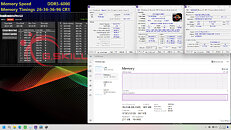
ASRock Displays Its New Taichi OCF and Creator, and Phantom Gaming X870E/X870 Motherboards
In addition to new graphics cards, ASRock also showcased a couple of new motherboards at the Computex 2025 show in Taipei, including the new X870E Taichi OCF, X870 Taichi Creator, as well as the new Phantom Gaming X870 Nova Wi-Fi motherboard.
The star of the show is the new X870E Taichi OCF, which is also the first OC Formula motherboard based on AMD platform. This feature packed motherboard will support AMD Ryzen 9000, 8000, and 7000 series processors on AM5 socket. It features a 25-power phase VRM with 110A SPS, has two DDR5 DIMM slots, two PCIe 5.0 x16 and single PCIe 4.0 x4 slot, a total of six M.2 ports (two of which are PCIe Gen 5 x4), plenty of USB ports, 5 Gbps Ethernet, integrated Wi-Fi 7 and Bluetooth, and most importantly, "Professional Overclocking Toolkit", which means that this one is aimed at some high overclocking. ASRock also showcased the new X870 Taichi Creator, a more standard motherboard that has 21-phase VRM design, but comes with Marvell's 5 Gbps and 10 Gbps Ethernet ports.
The star of the show is the new X870E Taichi OCF, which is also the first OC Formula motherboard based on AMD platform. This feature packed motherboard will support AMD Ryzen 9000, 8000, and 7000 series processors on AM5 socket. It features a 25-power phase VRM with 110A SPS, has two DDR5 DIMM slots, two PCIe 5.0 x16 and single PCIe 4.0 x4 slot, a total of six M.2 ports (two of which are PCIe Gen 5 x4), plenty of USB ports, 5 Gbps Ethernet, integrated Wi-Fi 7 and Bluetooth, and most importantly, "Professional Overclocking Toolkit", which means that this one is aimed at some high overclocking. ASRock also showcased the new X870 Taichi Creator, a more standard motherboard that has 21-phase VRM design, but comes with Marvell's 5 Gbps and 10 Gbps Ethernet ports.















































































